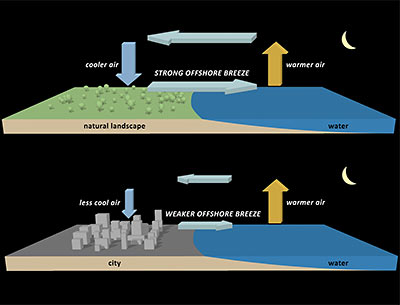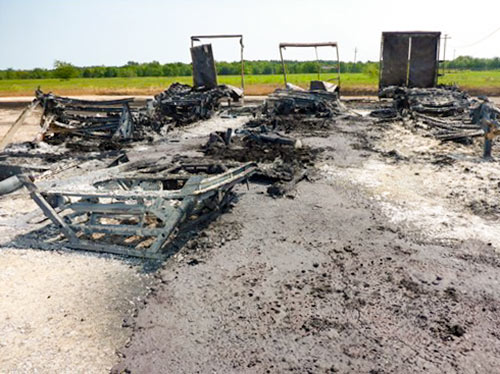
A new study from the National Center for Atmospheric Research documents how Houston’s vast expanse of paved surfaces allows the city to hold onto locally developed air pollution for longer periods of time, and prevents breezes that would otherwise naturally develop from sending all that nasty smog and stuff to outlying areas. Concrete and asphalt paving helps by soaking up heat during the daytime. This keeps land areas relatively warm overnight, which means there’s a lower contrast between land and sea temperatures during the summer. The result? Much less of those smog-stealing nighttime summer breezes. During the daytime, Houston buildings help to block local winds and keep things more still in the afternoon. Just another way standard development practices allow Houston to be a responsible steward of its own locally produced airborne products.
***
The study’s lead scientist, NCAR’s Fei Chen, projects that continued paving in the Houston area will help to still those messy, pollution-distributing breezes even further. The alternative, Chen suggests — adding more green spaces to the city or putting in lakes or ponds — would likely reduce nighttime temperatures, cause winds to pick up, and spill valuable Houston-born particulates over the Gulf of Mexico.
One computer simulation run by the scientists paints just such a nightmare scenario of a smog-spewing city: “If Houston were covered with cropland instead of pavement . . . inland air would heat up more than marine air during summer days and cause a sea breeze to blow onshore in the afternoon. Conversely, as the inland air became cooler than marine air overnight, a land breeze would blow offshore—potentially blowing away pollution.”
The scientists’ report, entitled “A numerical study of interactions between surface forcing and sea-breeze circulations and their effects on stagnation in the greater Houston area,” was developed with support from the U.S. Air Force Weather Agency, the U.S. Defense Threat Reduction Agency, and the National Science Foundation. It’ll hit the newsstands in the next edition of the Journal of Geophysical Research–Atmospheres.
Illustration: UCAR/Lex Ivy





Idea: A giant fan. Maybe we could use the Astrodome for that somehow?
Ah, yes, the dreaded urban heat island effect. And of course, those mega-churches with their big concrete parking lots are exempt from the drainage fee. Arrrgh!
All is have to say is one word (actually an acronym):
HIWI
Coastal sailors are accustomed to this effect– the afternoon winds off the coast of Florida are different off the urbanized sections of coastline– it can be felt miles offshore and seen in the cloud patterns of the thunderheads.
This theory seems full of holes. Nighttime reduction theory of winds makes sense: dT decreases, therefore winds decrease. Simple, easy to explain.
The explanation of supposed daytime reduction in winds is more like “homina-homina-homina”, (see Occam’s Razor)
and not clear in order to avoid making a statement that can be proved wrong (see falsifiability and scientific method).
Keep in mind that all of their data comes from a 9-day period in 2000 and a simulation built off this data. For those of you who remember, this was the hottest period EVER in Houston, when it was 108 at Hobby Airport, 109 at IAH, and 111 in The Woodlands/Tomball. So, not very representative of the weather in Houston.
During these record-breaking temperatures, winds were offshore (from the North) at the hottest time of the day. This is not the normal direction in the summer. However from their study: “During the day, the hot paved urban areas tend to draw in air from offshore. However, this air is offset by prevailing wind patterns that blow toward the water, resulting in relatively little net movement in the atmosphere over the city. “
Would it have killed them to research what the ACTUAL prevailing winds are in Houston? http://www.tceq.texas.gov/airquality/monops/windroses.html
Besides being catastrophically wrong, the authors are claiming that there should be locally induced nighttime, offshore winds due to the cooling of the land but also locally induced daytime, offshore winds due to the heating of the land. Which is it?
They also compare paved land to cropland, then jump to the conclusion that we need more parks and ponds. (Ponds would neither heat up as much as land during the day nor cool off as much as land at night. Plus, I don’t see any “ponds simulation” that they did.) Sorry, but if I get a new park in my area, I don’t want it to resemble cropland – no vegetation for 6 months then a little bit of vegetation. I want lots of trees! And I really don’t care if that slows down the local wind speed by 10% because I really like trees.
tl;dr:
-Daytime winds in Houston are probably higher with urbanization than natural landscape.
-Somebody do a real study!
-Make more parks for enjoyment, not for these pseudo-scientists.